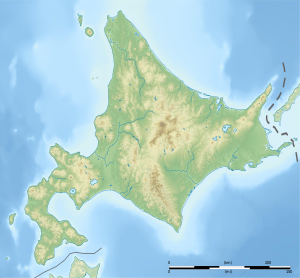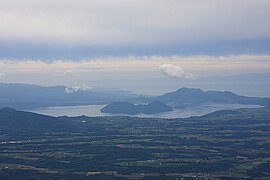Lake Tōya
| Lake Tōya | ||
|---|---|---|

|
||
| Geographical location | Japan , Hokkaidō , Shikotsu-Tōya National Park | |
| Tributaries | Sobetsu et al. a. | |
| Drain | Sobetsu | |
| Data | ||
| Coordinates | 42 ° 35 ' N , 140 ° 51' E | |
|
|
||
| Altitude above sea level | 84 m TP | |
| surface | 70.72 km² | |
| length | 9 km | |
| width | 11 km | |
| scope | 50 km | |
| Maximum depth | 179.7 m | |
The Tōya Lake ( Japanese 洞 爺 湖 , Tōya-ko ) is a volcanic caldera lake in Shikotsu-Tōya National Park in Iburi Sub-prefecture in southwest Hokkaidōs in Japan . The Tōya is the northernmost lake in Japan that never freezes over and is the second clearest lake in Japan after the Mashū lake.
There is a forest museum on Naka-no-shima ( 中 島 , German "island [in] the middle"; 4.85 km²), an island in the middle of the lake. The lake is the ninth largest in area, and as a caldera lake it is the third largest in Japan. The name Tōya comes from the Ainu language and is composed of the two words for lake (to) and shore (ya).
The lake belongs to the communities of Sōbetsu on the east bank and Tōyako on the west bank. The 34th G8 summit took place in the latter in 2008 .
fauna
The Japanese char ( Salvelinus leucomaenis ), the carp fish Ugui ( Tribolodon hakonensis ) and gobies are native to the lake . In addition, other species such as smelt , sockeye salmon ( Oncorhynchus nerka ), rainbow trout , masu salmon, carp and trout ( Salmo trutta ) etc. were released and settled in the lake. Sockeye salmon fish eggs were first introduced into the lake in 1893. In 1930, 25 tons of sockeye salmon were caught. The amount of fish caught rose to 100 t by 1950, but then the acidity of the water rose due to a nearby mine, which led to a decline in the total fish population. The water quality improves slowly over the years, so that in 1986 50 tons of sockeye salmon were caught again. The smelt was brought from the inland lake Kasumigaura to Lake Tōya in 1912 , the rainbow trout was released in 1926, the Masu salmon in 1928.
In addition to the various types of fish, sika deer live on the small island of Naka-no-shima in the center of the lake . In 1957 a single male and a year later a female were brought to the island. In 1965 a second female was brought to the island. The maximum number of sika deer temporarily reached 400 animals.
gallery
Web links
Individual evidence
- ↑ 湖沼 面積 . (PDF; 114 kB) (No longer available online.) Kokudo Chiriin , October 1, 2015, archived from the original on August 5, 2016 ; Retrieved August 5, 2016 (Japanese). Info: The archive link was inserted automatically and has not yet been checked. Please check the original and archive link according to the instructions and then remove this notice.
- ↑ a b 日本 の 主 な 湖沼 . (No longer available online.) MLIT , 2002, archived from the original on September 12, 2013 ; Retrieved September 15, 2013 (Japanese). Info: The archive link was inserted automatically and has not yet been checked. Please check the original and archive link according to the instructions and then remove this notice.
- ↑ Hiroyuki Sakano, Masahide Kaeriyama, Hiroshi Ueda, Yasunari Sakurai, Kenji Shimazaki: Growth pattern and age determination by scales of lacustrine sockeye salmon in Lake Toya . In: University of Hokkaido (Ed.): Scientific Reports of the Hokkaido Salmon Hatchery . No. 50 . Hakodate November 1996, p. 125-138 (Japanese, affrc.go.jp [PDF]).



